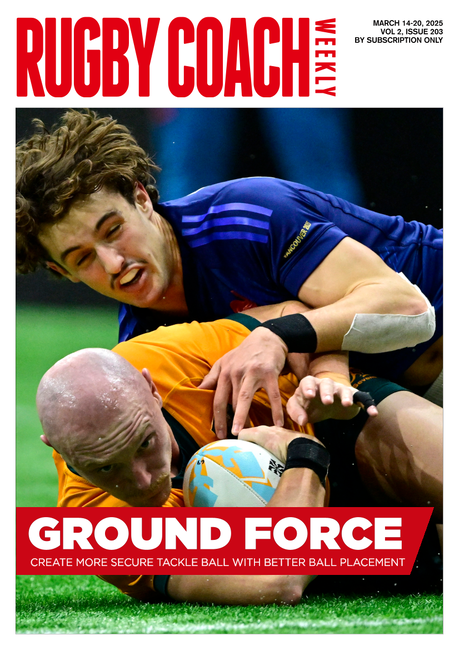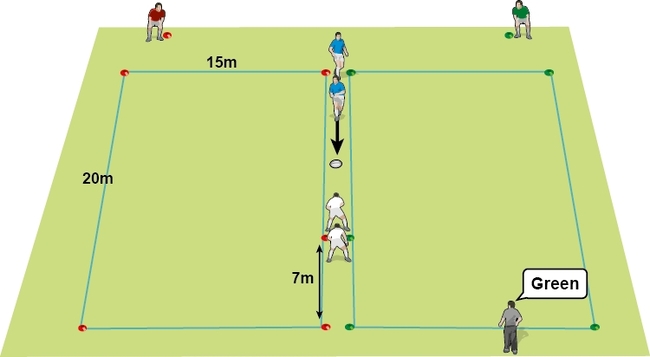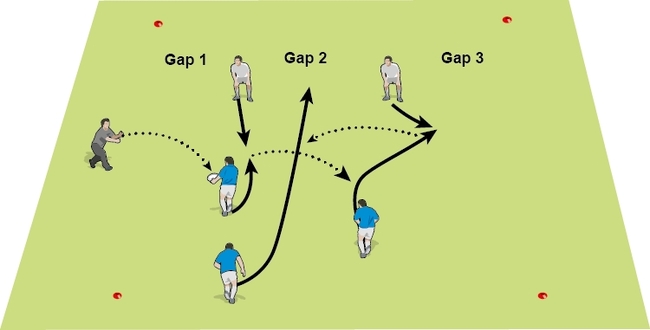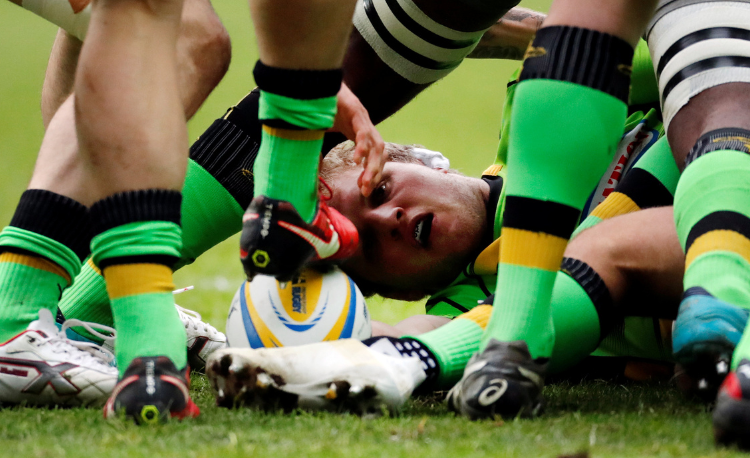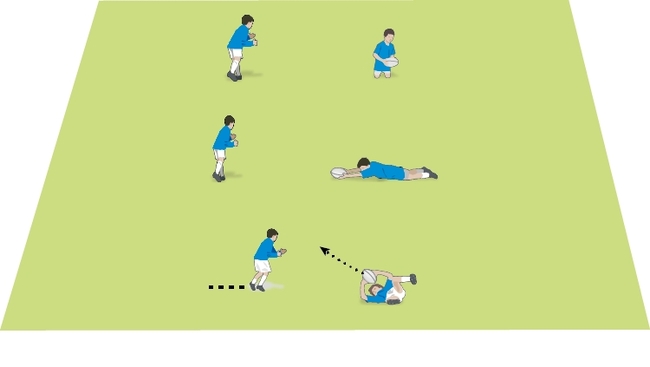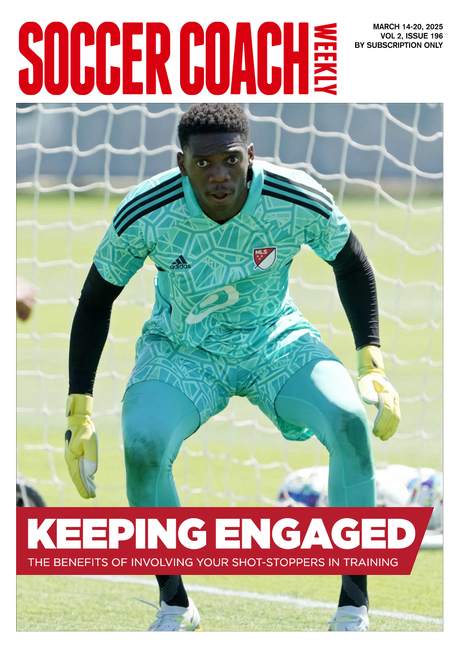Rugby coaching tips for pop passes
Passing and Handlingby Dan Cottrell
"Pop" passes are short passes where the passer "hangs" the ball in space for the receiver to run on to it. Often the ball carrier has already drawn away his opposite man, creating space for his team-mate to make the break.
To create a rugby coaching drill for this, I devised an exercise called "Pop Cycles". What I like about this rugby drill is that it can easily be developed with longer channels, different widths and varying degrees of defence.
This means you can come back to the rugby drill session time and again, but with enough variation to keep the players on their toes. The more competitive game after the main session also isolates the key rugby skills in a game-like environment, by working the players in narrow channels.
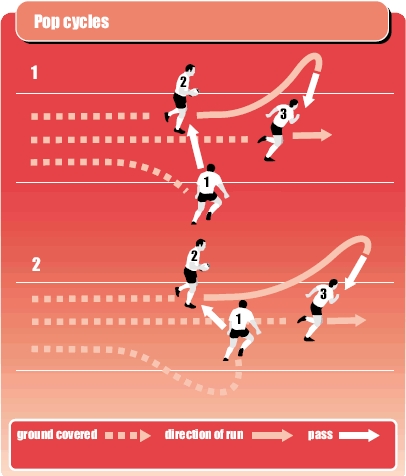
Setting up the rugby training session
What you tell your players the session is about:
Set up a long, five metre wide channel. Put four or five players in a line, one with a ball. The ball carrier runs forwards then steps outside the channel. He passes the ball back into the channel, so the next player can accelerate onto the ball. This player immediately changes direction to run outside the other edge of the channel, before passing the ball back in.
Repeat the drill until every player has passed the ball at least twice. Then develop the exercise by having alternate players go out and back in to the channel before passing the ball.
Drill session developments
What to call out
Key phrases you might find handy, in addition to the usual words of encouragement when you're running this rugby coaching drill:
Some common problems you may encounter.
Set up a pitch with four narrow channels, each with two defenders, one 5 metres behind the other. Start with four attackers and designate one of the channels through which you want them to attack. The ball must not leave this channel once the attackers have entered it. The defenders can move sideways but not backwards or forwards.
Develop the game by allowing the attackers to attack any channel they want, on the condition that once entered, they cannot change the channel. Also think about adding defenders and reducing the space between them to increase the intensity.
Click the link for a rugby drill to bump, pop, rip.
Click the link to order a copy of Coaching Rugby, a comprehensive training manual to teach basic skills to young rugby players.
To create a rugby coaching drill for this, I devised an exercise called "Pop Cycles". What I like about this rugby drill is that it can easily be developed with longer channels, different widths and varying degrees of defence.
This means you can come back to the rugby drill session time and again, but with enough variation to keep the players on their toes. The more competitive game after the main session also isolates the key rugby skills in a game-like environment, by working the players in narrow channels.

Setting up the rugby training session
What you tell your players the session is about:
- Creating space in a narrow area by changing your angles of running and passing.
- Allowing supporting players to attack space in a narrow area with short passes.
- When carrying the ball, keep changing your running lines to exploit every bit of space.
- When waiting to receive, read the ball carrier's movements and be prepared to "explode" onto the ball.
Set up a long, five metre wide channel. Put four or five players in a line, one with a ball. The ball carrier runs forwards then steps outside the channel. He passes the ball back into the channel, so the next player can accelerate onto the ball. This player immediately changes direction to run outside the other edge of the channel, before passing the ball back in.
Repeat the drill until every player has passed the ball at least twice. Then develop the exercise by having alternate players go out and back in to the channel before passing the ball.
Drill session developments
- Shorten the length of the channel so players have to change the angles of their runs and make their passes more quickly.
- Set up two channels running side by side. The players from each channel have to run through the other channel after completing a certain distance in their own channel.
What to call out
Key phrases you might find handy, in addition to the usual words of encouragement when you're running this rugby coaching drill:
- "Passer: pass for the supporter, not to them."
- "Passer: give the ball some loop."
- "Passer: exaggerate your changes of angle."
- "Receiver: hold your run and react to the passer's movements."
- "Receiver: accelerate onto the ball."
Some common problems you may encounter.
- Forward passes. The change of running angles can mean that the passer turns their shoulders away from the intended direction of the pass. They must extend their arms in front of their body and flick the wrists to deliver the pass.
- Players receiving the ball outside the narrow channel. You must keep the players disciplined to explore the techniques in more depth and develop their skills.
- Ways to challenge your players further, develop their individual rugby skills or incorporate the techniques into a game.
- Should the passer always be using two hands to pass the ball? Are there any benefits to making pop passes one-handed?
- Who decides whether the pass should be on the left or the right of the passer? Does it work differently for different players? Is there a need for the receiver to communicate?
- What sort of trick passes can be used, for instance over the shoulder or behind the back?
Set up a pitch with four narrow channels, each with two defenders, one 5 metres behind the other. Start with four attackers and designate one of the channels through which you want them to attack. The ball must not leave this channel once the attackers have entered it. The defenders can move sideways but not backwards or forwards.
Develop the game by allowing the attackers to attack any channel they want, on the condition that once entered, they cannot change the channel. Also think about adding defenders and reducing the space between them to increase the intensity.
Click the link for a rugby drill to bump, pop, rip.
Click the link to order a copy of Coaching Rugby, a comprehensive training manual to teach basic skills to young rugby players.
Newsletter Sign Up
Coaches Testimonials

Gerald Kearney, Downtown Las Vegas Soccer Club

Paul Butler, Florida, USA

Rick Shields, Springboro, USA

Tony Green, Pierrefonds Titans, Quebec, Canada
Subscribe Today
Be a more effective, more successful rugby coach
In a recent survey 89% of subscribers said Rugby Coach Weekly makes them more confident, 91% said Rugby Coach Weekly makes them a more effective coach and 93% said Rugby Coach Weekly makes them more inspired.
Get Weekly Inspiration
All the latest techniques and approaches
Rugby Coach Weekly offers proven and easy to use rugby drills, coaching sessions, practice plans, small-sided games, warm-ups, training tips and advice.
We've been at the cutting edge of rugby coaching since we launched in 2005, creating resources for the grassroots youth coach, following best practice from around the world and insights from the professional game.


